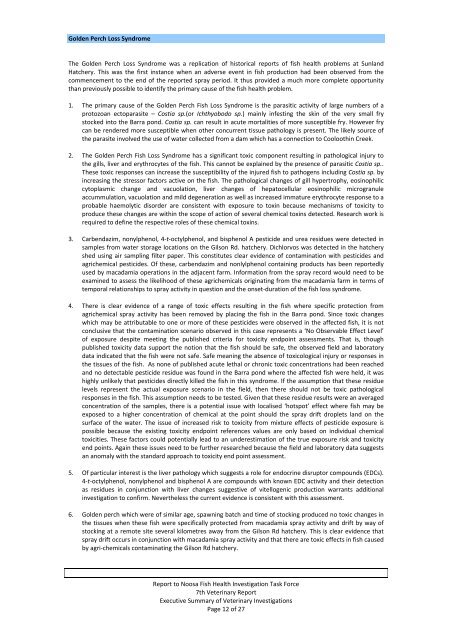37 7th Veterinary Report - Department of Primary Industries ...
37 7th Veterinary Report - Department of Primary Industries ...
37 7th Veterinary Report - Department of Primary Industries ...
Create successful ePaper yourself
Turn your PDF publications into a flip-book with our unique Google optimized e-Paper software.
Golden Perch Loss Syndrome<br />
The Golden Perch Loss Syndrome was a replication <strong>of</strong> historical reports <strong>of</strong> fish health problems at Sunland<br />
Hatchery. This was the first instance when an adverse event in fish production had been observed from the<br />
commencement to the end <strong>of</strong> the reported spray period. It thus provided a much more complete opportunity<br />
than previously possible to identify the primary cause <strong>of</strong> the fish health problem.<br />
1. The primary cause <strong>of</strong> the Golden Perch Fish Loss Syndrome is the parasitic activity <strong>of</strong> large numbers <strong>of</strong> a<br />
protozoan ectoparasite – Costia sp.(or Ichthyobodo sp.) mainly infesting the skin <strong>of</strong> the very small fry<br />
stocked into the Barra pond. Costia sp. can result in acute mortalities <strong>of</strong> more susceptible fry. However fry<br />
can be rendered more susceptible when other concurrent tissue pathology is present. The likely source <strong>of</strong><br />
the parasite involved the use <strong>of</strong> water collected from a dam which has a connection to Cooloothin Creek.<br />
2. The Golden Perch Fish Loss Syndrome has a significant toxic component resulting in pathological injury to<br />
the gills, liver and erythrocytes <strong>of</strong> the fish. This cannot be explained by the presence <strong>of</strong> parasitic Costia sp..<br />
These toxic responses can increase the susceptibility <strong>of</strong> the injured fish to pathogens including Costia sp. by<br />
increasing the stressor factors active on the fish. The pathological changes <strong>of</strong> gill hypertrophy, eosinophilic<br />
cytoplasmic change and vacuolation, liver changes <strong>of</strong> hepatocellular eosinophilic microgranule<br />
accummulation, vacuolation and mild degeneration as well as increased immature erythrocyte response to a<br />
probable haemolytic disorder are consistent with exposure to toxin because mechanisms <strong>of</strong> toxicity to<br />
produce these changes are within the scope <strong>of</strong> action <strong>of</strong> several chemical toxins detected. Research work is<br />
required to define the respective roles <strong>of</strong> these chemical toxins.<br />
3. Carbendazim, nonylphenol, 4‐t‐octylphenol, and bisphenol A pesticide and urea residues were detected in<br />
samples from water storage locations on the Gilson Rd. hatchery. Dichlorvos was detected in the hatchery<br />
shed using air sampling filter paper. This constitutes clear evidence <strong>of</strong> contamination with pesticides and<br />
agrichemical pesticides. Of these, carbendazim and nonlylphenol containing products has been reportedly<br />
used by macadamia operations in the adjacent farm. Information from the spray record would need to be<br />
examined to assess the likelihood <strong>of</strong> these agrichemicals originating from the macadamia farm in terms <strong>of</strong><br />
temporal relationships to spray activity in question and the onset‐duration <strong>of</strong> the fish loss syndrome.<br />
4. There is clear evidence <strong>of</strong> a range <strong>of</strong> toxic effects resulting in the fish where specific protection from<br />
agrichemical spray activity has been removed by placing the fish in the Barra pond. Since toxic changes<br />
which may be attributable to one or more <strong>of</strong> these pesticides were observed in the affected fish, it is not<br />
conclusive that the contamination scenario observed in this case represents a ‘No Observable Effect Level’<br />
<strong>of</strong> exposure despite meeting the published criteria for toxicity endpoint assessments. That is, though<br />
published toxicity data support the notion that the fish should be safe, the observed field and laboratory<br />
data indicated that the fish were not safe. Safe meaning the absence <strong>of</strong> toxicological injury or responses in<br />
the tissues <strong>of</strong> the fish. As none <strong>of</strong> published acute lethal or chronic toxic concentrations had been reached<br />
and no detectable pesticide residue was found in the Barra pond where the affected fish were held, it was<br />
highly unlikely that pesticides directly killed the fish in this syndrome. If the assumption that these residue<br />
levels represent the actual exposure scenario in the field, then there should not be toxic pathological<br />
responses in the fish. This assumption needs to be tested. Given that these residue results were an averaged<br />
concentration <strong>of</strong> the samples, there is a potential issue with localised ‘hotspot’ effect where fish may be<br />
exposed to a higher concentration <strong>of</strong> chemical at the point should the spray drift droplets land on the<br />
surface <strong>of</strong> the water. The issue <strong>of</strong> increased risk to toxicity from mixture effects <strong>of</strong> pesticide exposure is<br />
possible because the existing toxicity endpoint references values are only based on individual chemical<br />
toxicities. These factors could potentially lead to an underestimation <strong>of</strong> the true exposure risk and toxicity<br />
end points. Again these issues need to be further researched because the field and laboratory data suggests<br />
an anomaly with the standard approach to toxicity end point assessment.<br />
5. Of particular interest is the liver pathology which suggests a role for endocrine disruptor compounds (EDCs).<br />
4‐t‐octylphenol, nonylphenol and bisphenol A are compounds with known EDC activity and their detection<br />
as residues in conjunction with liver changes suggestive <strong>of</strong> vitellogenic production warrants additional<br />
investigation to confirm. Nevertheless the current evidence is consistent with this assessment.<br />
6. Golden perch which were <strong>of</strong> similar age, spawning batch and time <strong>of</strong> stocking produced no toxic changes in<br />
the tissues when these fish were specifically protected from macadamia spray activity and drift by way <strong>of</strong><br />
stocking at a remote site several kilometres away from the Gilson Rd hatchery. This is clear evidence that<br />
spray drift occurs in conjunction with macadamia spray activity and that there are toxic effects in fish caused<br />
by agri‐chemicals contaminating the Gilson Rd hatchery.<br />
<strong>Report</strong> to Noosa Fish Health Investigation Task Force<br />
<strong>7th</strong> <strong>Veterinary</strong> <strong>Report</strong><br />
Executive Summary <strong>of</strong> <strong>Veterinary</strong> Investigations<br />
Page 12 <strong>of</strong> 27

















